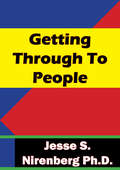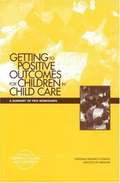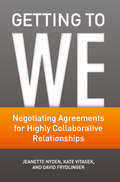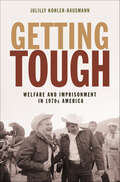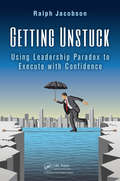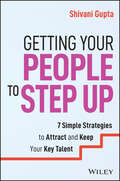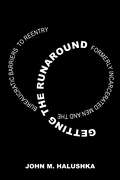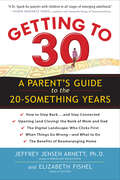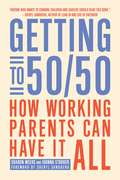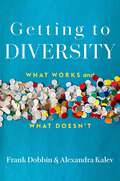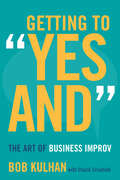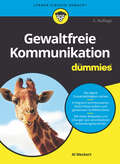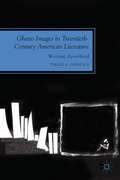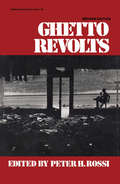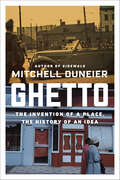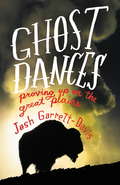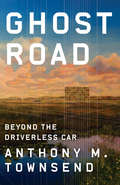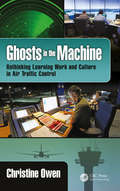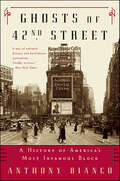- Table View
- List View
Getting Through To People
by Jesse S. NirenbergIf you think you can't reach all the people all the time - think again! Now you can persuade even the most stubborn or hostile audience to see your point of view with these proven techniques from Dr. Jesse S. Nirenberg. Through dozens of anecdotes, you'll learn how to control conversations with emotional people, how to hold other people's attention, and how to decode what people are really trying to tell you. And you'll discover how to reach the most shy and private people and make them want to open up to you. Getting Through to People invites you to join the over 300,000 people using these powerful methods to break through the mental barriers that obstruct true person-to-person communication, and enhance your personal and business success.-Audio ed.
Getting To Positive Outcomes For Children In Child Care: A Summary Of Two Workshops
by Board On Children Families YouthA summary on Getting To Positive Outcomes For Children In Child Care
Getting To We
by Kate Vitasek Jeanette Nyden David FrydlingerDrawing on best practices and real examples from companies who are achieving record results, Getting to We flips conventional negotiation on its head, shifting the perspective from a tug of war between parties to a collaborative partnership where both sides effectively pull against a business problem.
Getting Tough: Welfare and Imprisonment in 1970s America (Politics and Society in Modern America)
by Julilly Kohler-HausmannThe politics and policies that led to America's expansion of the penal system and reduction of welfare programsIn 1970s America, politicians began "getting tough" on drugs, crime, and welfare. These campaigns helped expand the nation's penal system, discredit welfare programs, and cast blame for the era's social upheaval on racialized deviants that the state was not accountable to serve or represent. Getting Tough sheds light on how this unprecedented growth of the penal system and the evisceration of the nation's welfare programs developed hand in hand. Julilly Kohler-Hausmann shows that these historical events were animated by struggles over how to interpret and respond to the inequality and disorder that crested during this period.When social movements and the slowing economy destabilized the U.S. welfare state, politicians reacted by repudiating the commitment to individual rehabilitation that had governed penal and social programs for decades. In its place, they championed strategies of punishment, surveillance, and containment. The architects of these tough strategies insisted they were necessary, given the failure of liberal social programs and the supposed pathological culture within poor African American and Latino communities. Kohler-Hausmann rejects this explanation and describes how the spectacle of enacting punitive policies convinced many Americans that social investment was counterproductive and the "underclass" could be managed only through coercion and force.Getting Tough illuminates this narrative through three legislative cases: New York's adoption of the 1973 Rockefeller drug laws, Illinois's and California's attempts to reform welfare through criminalization and work mandates, and California's passing of a 1976 sentencing law that abandoned rehabilitation as an aim of incarceration. Spanning diverse institutions and weaving together the perspectives of opponents, supporters, and targets of punitive policies, Getting Tough offers new interpretations of dramatic transformations in the modern American state.
Getting Unstuck: Using Leadership Paradox to Execute with Confidence
by Ralph JacobsonThis book demonstrates how organization leaders who balance several key paradoxes achieve greater growth and sustainability in the long term than those who use financial data alone. It addresses the issues that are the most troublesome to people and the organizations they work for. The author provides deep insight into the root causes of workplace issues and provides practical language and tools to address the paradoxes that seem to block the achievement of success and life satisfactions.
Getting Your People to Step Up: 7 Simple Strategies to Attract and Keep Your Key Talent
by Shivani GuptaA roadmap for hiring, coaching and motivating top performers In business, your people are your most important asset. But finding, training and motivating the right people can be daunting and costly. If you want to keep your best employees — and grow your business with their support — then Getting Your People to Step Up is the book for you! Business coach Shivani Gupta reveals seven proven strategies to help you recruit top talent and ensure your employees are happier, more engaged and more productive. Getting Your People to Step Up offers a no-nonsense approach to hiring, managing and empowering your staff. You’ll learn how to coach your team and be a leader who inspires growth and loyalty. When the right employees are highly engaged and performing, running your business is not only more profitable: it becomes fun! Get strategies to recruit and incentivise the best people Combat employee burnout and prevent high turnover Transform your leadership style and coach for success Create a shared vision for your business that unites your team and fosters collaboration Communicate more effectively to set expectations and deliver feedback for growth Create a positive work environment with a culture of diversity and inclusion Don’t hire fast and fire faster. Avoid costly mistakes: find the right person for the job, and enable them to thrive. With Getting Your People to Step Up, you’ll learn how to unlock the long-term potential of your team so that your business can truly flourish.
Getting the Runaround: Formerly Incarcerated Men and the Bureaucratic Barriers to Reentry
by John M. HalushkaGetting the Runaround takes readers into the bureaucratic spaces of prisoner reentry, examining how returning citizens navigate the "institutional circuit" of parole offices, public assistance programs, rehabilitation facilities, shelters, and family courts. Drawing on three years of ethnographic fieldwork and forty-five in-depth interviews with formerly incarcerated men returning to New York City, John M. Halushka argues that the very institutions charged with facilitating the transition from incarceration to community life perversely undermine reintegration by imposing a litany of bureaucratic obstacles. This "runaround" is not merely a series of inconveniences but rather an extension of state punishment that exacerbates material poverty and diminishes citizenship rights. By telling the stories of men caught in vicious cycles of poverty, bureaucratic processing, and social control, Halushka demonstrates the urgent need to shift reentry away from an austerity-driven, compliance-based framework and toward a vision of social justice and inclusion.
Getting to 30: A Parent's Guide to the 20-Something Years
by Elizabeth Fishel Jeffrey Jensen Arnett“This is the book parents have been waiting for”—Michael Thompson, coauthor of Raising Cain. The book that is “helpful, hopeful, and engaging”—Jeanne Brooks-Gunn, Ph.D., Columbia University. It is the book that addresses the new reality for parents of kids in their 20s and the issues that everyone in the media is talking about: When will this new generation of 20-somethings leave home, find love, start a career, settle down—grow up? And it's the book that will soothe your nerves. It’s loaded with information about what to expect and guidance on what to do when problems arise (as they probably will). In other words, this is the book parents need—Getting to 30, by Jeffrey Jensen Arnett, the world's leading authority on the post-adolescent phase he named emerging adulthood, and Elizabeth Fishel, author of Sisters and other books. As Getting to 30 shows, the road to adulthood is longer than we think—and, for parents, bumpier. It explains what’s really happening to your 18- to 29-year-old, including the story behind your child’s moods. The phenomenon of the boomerang child—and why it’s actually a good thing, for parents and kids. The new landscape of 20-something romance. And it gives all the tools parents need to deal with the challenges, from six ways to listen more than you talk, to knowing when to open (and close) the Bank of Mom and Dad while saving for retirement, to figuring out the protocol for social media. Published in hardcover as When Will My Grown-Up Kid Grow Up?, Getting to 30 includes the latest research on the optimistic and supportive attitude most parents have regarding their 20-something children.
Getting to 50/50
by Sharon Meers Joanna Strober Sheryl SandbergSharon Meers and Joanna Strober are professionals, wives, and mothers. They understand the challenges and rewards of two-career households. They also know that families thrive not in spite of working mothers but because of them. You can have a great career, a great marriage, and be a great mother. The key is tapping into your best resource and most powerful ally-the man you married.After interviewing hundreds of parents and employers, surveying more than a thousand working mothers, and combing through the latest government and social science research, the authors have discovered that kids, husbands, and wives all reap huge benefits when couples commit to share equally as breadwinners and caregivers. Mothers work without guilt, fathers bond with their kids, and children blossom with the attention of two involved parents.The starting point? An attitude shift that puts you on the road to 50/50-plus the positive step-by-step advice in this book.From "baby boot camp" for new dads to exactly what to say when negotiating a leave with the boss, this savvy book offers fresh ideas to today's families offering encouragement, hope, and confidence to any woman who has ever questioned her choices regarding work and family.
Getting to Diversity: What Works and What Doesn’t
by Frank Dobbin Alexandra Kalev“Too many companies don’t know how to walk the walk of diversity, equity, and inclusion. Getting to Diversity shows them how.”—Lori George Billingsley, former Global Chief DEI Officer, Coca-Cola CompanyIn an authoritative, data-driven account, two of the world’s leading management experts challenge dominant approaches to increasing workplace diversity and provide a comprehensive account of what really works.Every year America becomes more diverse, but change in the makeup of the management ranks has stalled. The problem has become an urgent matter of national debate. How do we fix it? Bestselling books preach moral reformation. Employers, however well intentioned, follow guesswork and whatever their peers happen to be doing. Arguing that it’s time to focus on changing systems rather than individuals, two of the world’s leading experts on workplace diversity show us a better way in the first comprehensive, data-driven analysis of what succeeds and what fails. The surprising results will change how America works.Frank Dobbin and Alexandra Kalev draw on more than thirty years of data from eight hundred companies as well as in-depth interviews with managers. The research shows just how little companies gain from standard practice: sending managers to diversity training to reveal their biases, then following up with hiring and promotion rules, and sanctions, to shape their behavior. Almost nothing changes. It’s time, Dobbin and Kalev argue, to focus on changing the management systems that make it hard for women and people of color to succeed. They show us how the best firms are pioneering new recruitment, mentoring, and skill training systems, and implementing strategies for mixing segregated work groups to increase diversity. They explain what a difference ambitious work–life programs make. And they argue that as firms adopt new systems, the key to making them work is to make them accessible to all—not just the favored few.Powerful, authoritative, and driven by a commitment to change, Getting to Diversity is the book we need now to address constructively one of the most fraught challenges in American life.
Getting to “Yes And”: The Art of Business Improv
by Chuck Crisafulli Bob KulhanAmidst the deluge of advice for businesspeople, there lies an overlooked tool, a key to thriving in today's fast-paced, unpredictable environment: improvisation. In Getting to "Yes And" veteran improv performer, university professor, CEO, and consultant Bob Kulhan unpacks a form of mental agility with powers far beyond the entertainment value of comedy troupes. Drawing on principles from cognitive and social psychology, behavioral economics, and communication, Kulhan teaches readers to think on their feet and approach the most typical business challenges with fresh eyes and openness. He shows how improv techniques such as the "Yes, and" approach, divergent and convergent thinking, and focusing on being present can translate into more productive meetings, swifter decisions, stronger collaboration, positive conflict resolution, mindfulness, and more. Moving from the individual to the organizational level, Kulhan compiles time-tested teaching methods and training exercises into an instrumental guide that readers can readily implement as a party of one or a company of thousands.
Gewalt in den Anden: Systemtheoretische Überlegungen zu Gewaltstrukturen in Kolumbien (Innovative Konfliktforschung – Innovation in Conflict Research)
by Bettina M.E. BenzingDas Buch beschäftigt sich mit den langfristigen sozialstrukturellen Auswirkungen von Gewaltkonflikten in Postkonfliktgesellschaften, eines der aktuellsten Forschungsthemen der Friedens- und Konfliktforschung. Basierend auf empirischer Forschung in verschiedenen Landesteilen Kolumbiens wird argumentiert, dass sich die unter Gewalteinfluss entstandenen Sozialstrukturen primär durch Misstrauensmechanismen in der Gesellschaft auszeichnen, wodurch sich einerseits Gewalt als Kommunikationsmuster auch nach Friedensschlüssen weiter erhält und reproduziert sowie andererseits sich exkludierende Strukturen für marginalisierte Bevölkerungsteile ausbilden, die einem Frieden nachhaltig entgegenwirken. Mittels eines systemtheoretischen Ansatzes macht das Buch daher ein Angebot zum besseren Verständnis anhaltender Gewalt in Postkonfliktgesellschaften.
Gewalt- und Krisenprävention in Beruf und Alltag: Ursachen und Lösungen für Gewalt und Krisen
by Rudi Heimann Jürgen FritzscheDer Herausgeberband gibt einen anwenderorientierten Überblick zu Ursachen und Entwicklungen von Bedrohungen, Gewalt und daraus entstehender Krisen im beruflichen Kontext und im Alltag. Ein interdisziplinäres Autorenteam stellt neben den Grundlagen die wichtigsten Methoden zur Bewältigung sich entwickelnder und bereits offener Gewalt- und Krisensituationen vor. Der Schwerpunkt liegt im Anwendungsteil auf angemessener konfliktfreier Lösung und der konsequenten Verfolgung alternativer Möglichkeiten, wenn eine konfliktfreie Bewältigung nicht mehr möglich ist. Sicherheitskonzepten und praktikablen Deeskalationsmodellen wird ebenso wie massiven Krisen ein Platz eingeräumt.Die Zielgruppen sind Führungskräfte und Mitarbeitende in öffentlichen Verwaltungen, Justiz, Schulen, Geldinstituten, im Gesundheitswesen, öffentlichen Personennahverkehr oder in vergleichbaren Einrichtungen, Verantwortliche wie Sicherheits- und Präventionsbeauftragte in diesen Bereichen, Trainer für Sicherheitsthemen und Interessierte im privaten Umfeld.Die Herausgeber sind Rudi Heimann, Leitender Polizeidirektor, Experte für Gewaltschutz und Krisenbewältigung, Keynote Speaker und Leiter einer Zentralen Ausländerbehörde, sowieDr. Jürgen Fritzsche, sportwissenschaftlicher Berater, Coach und Gewaltschutztrainer (EXperts for TRAining), ehemaliger Bundeslehrwart des Deutschen Karateverbandes, international tätiger Dozent und Technischer Direktor des luxemburgischen Karateverbandes.Empfehlung der DGUV“Im vorliegenden Buch ist es gelungen, die aktuellen Erkenntnisse zum Thema Gewalt umfassend und gleichzeitig alltagsnah aufzubereiten. Eine besondere Stärke liegt in der Interdisziplinarität […], die Einblicke in verschiedenste wissenschaftliche Bereiche gewährt. Klare Handlungsempfehlungen schützen bei einem potentiell gewalttätigen Konflikt vor einer weiteren Eskalation.”Dr. Stefan HussyHauptgeschäftsführer der Deutschen Gesetzlichen Unfallversicherung (DGUV)
Gewalterfahrungen gehörloser Frauen: Risikofaktoren, Ressourcen und gesundheitliche Folgen (Sozialer Wandel und Kohäsionsforschung)
by Sabine FriesDie Erkenntnis, dass gehörlose Frauen von verschiedenen Formen von Gewalt und ihren Folgen genauso oder sogar weit häufiger betroffen sein können als andere Frauen, ist in der Öffentlichkeit kaum bekannt. Ein stark erhöhtes Risiko für Gewalterfahrungen ergibt sich bei gehörlosen Frauen vor allem aufgrund einer ausgeprägten gesellschaftlichen Isolation. Ein weiterer wesentlicher Risikofaktor für die im Vergleich zu Frauen mit und ohne Behinderungen überdurchschnittlich hohe Gewaltbetroffenheit gehörloser Frauen ist ihre häufig alternativlose Einbindung in die Gehörlosengemeinschaft. Dies verweist darauf, dass unsere Gesellschaft bislang daran gescheitert ist, gehörlose Menschen ausreichend zu integrieren, und diese so marginalisiert hat, dass sie von der Mehrheitsgesellschaft weitgehend unbemerkt zu Tätern und Opfern werden. Nicht zuletzt hat Gewalt gegen gehörlose Frauen komplexe und weitreichende gesundheitliche Folgen. Das Gesundheitssystem nimmt deshalb eine Schlüsselrolle für die Prävention, Weitervermittlung und Intervention bei Gewalt gegen gehörlose Frauen und ihre Kinder ein.
Gewaltfreie Kommunikation für Dummies (Für Dummies)
by Al WeckertMöchten auch Sie einfühlsamer kommunizieren? Al Weckert erläutert Ihnen die vier Schritte der Gewaltfreien Kommunikation nach Marshall B. Rosenberg: urteilsfreie Beobachtung, Gefühle, Bedürfnisse, Bitten, die eine wertschätzende Kommunikation mit dem Gegenüber ermöglichen. Sie erfahren anhand vieler Beispiele und Übungen, wie die Gewaltfreie Kommunikation im Beruf, in der Partnerschaft und der Erziehung Konflikte entschärft und hilft, Lösungen zu finden, in denen die Belange aller Beteiligten berücksichtigt werden. Außerdem gibt er denen, die Gewaltfreie Kommunikation weitergeben wollen, zahlreiche Hinweise zur Aus- und Weiterbildung.
Gewaltgedächtnisse: Analysen zur Präsenz vergangener Gewalt (Soziales Gedächtnis, Erinnern und Vergessen – Memory Studies)
by Oliver Dimbath Nina LeonhardGewalt hat stets eine Geschichte. Diese bezieht sich sowohl auf das, was vor einem Gewaltereignis geschehen ist, als auch darauf, was nach diesem Ereignis eintritt. Gedächtnissoziologisch gefasst, wirft dies Fragen nach den Verkettungen und Bahnungen von Gewalt im Verlauf der Zeit auf. Von zentraler Bedeutung ist hier das Moment der Störung sozialer Ordnung, welches Gewalthandeln ebenso auslösen kann, wie es aus diesem in der Regel resultiert. In der Folge kommt es dann zur gewaltsamen oder gewaltlosen (Re-)Konsolidierung sozialer Ordnung. Die in diesem Band versammelten Beiträge analysieren sozialtheoretisch und anhand von Fallbeispielen, wie Gewalt fortgesetzt oder unterbrochen, verschwiegen oder thematisiert, legitimiert oder verurteilt wird. Auf diese Weise arbeiten sie Muster und Mechanismen von Sinn- beziehungsweise Strukturbildungsprozessen des gedächtnishaften und mitunter erinnernden Rückbezugs auf vergangene Gewaltereignisse heraus.
Gewissensinterpretationen im Alltag: Möglichkeiten für eine Operationalisierung autonomer und heteronomer Formen moralischer Bindungen
by Marcus HeiseFür die Sozialwissenschaften erscheint das Gewissen als hilfreiches Erklärungskonzept, weil es das Zusammenspiel von Emotionen, moralischen Standards und Prozessen der Selbstreflexion betont. Allerdings illustriert diese große Bandbreite an Phänomenen ebenso die Schwierigkeiten darin, das Gewissen auf theoretisch überzeugende Weise als ein empirisches Konzept abzugrenzen. Unter Rückgriff auf begriffsgeschichtliche Eckpunkte und kognitionstheoretische Ansätze postuliert der Autor, dass individuelle Gewissensinterpretationen zusammenhängende, proximale Konstituenten moralischer Bindungen darstellen und sie in diesem Sinne indikativ sind für die individuelle Verankerung von Moral. Die vorgeschlagene Operationalisierung autonomer und heteronomer Formen moralischer Bindungen, die induktiv auf der Grundlage typenbildender statistischer Verfahren entwickelt wird, bildet einen Kompromiss, der einerseits versucht, eine simplifizierende Dichotomie zwischen autonomen und heteronomen Formen moralischer Bindungen zu vermeiden, dabei aber gleichzeitig die Komplexität reduziert, in der sich Gewissenserfahrungen im Alltag bemerkbar machen. Das Verfahren der latenten Profilanalyse erlaubt entsprechende Zusammenhangsanalysen zwischen verschiedenen Gewissenstypen und sozialpsychologischen Konzepten im Rahmen eines integrierten, statistischen Modells.
Gewollte Kinderlosigkeit: Theoretische Einordnung und empirische Erkenntnisse zur Entscheidung von Frauen für ein Leben ohne Kinder
by Claudia Rahnfeld Annkatrin HeuschkelKernanliegen des Buches ist es, das Thema der gewollten und ungewollten Kinderlosigkeit fachlich konkreter zu trennen und das Phänomen der gewollten Kinderlosigkeit empirisch zu untersetzen. Das individuelle Lebenskonzept wirkt sich gleichermaßen auf die Möglichkeiten der persönlichen Selbstverwirklichung sowie das System der Gesellschaft, deren Organisation und Funktion aus. Wissenschaftliche Studien zu den Ursachen gewollter Kinderlosigkeit sind bisher jedoch kaum vorhanden. Die quantitative Befragung von über 1000 Frauen, bei denen eine bewusste Entscheidung für ein Leben ohne Kinder vorliegt, schließt die bestehende Forschungslücke. Die vorliegende Untersuchung trägt zu mehr Transparenz, Akzeptanz sowie Sensibilität gegenüber den Individuen sowie deren Lebensform bei und erweitert die sozialwissenschaftlichen Erkenntnisse zu weiblicher Selbstbestimmung, modernen Lebensmodellen und alternativen Familienformen.
Ghetto Images in Twentieth-Century American Literature
by Tyrone R. Simpson IIThis book explores how six American writers have artistically responded to the racialization of U. S. frostbelt cities in the twentieth century. Using the critical tools of spatial theory, critical race theory, urban history and sociology, Simpson explains how these writers imagine the subjective response to the race-making power of space.
Ghetto Revolts
by Peter H. RossiFor the past decade, transaction, and now Society, has dedicated itself to the task of reporting the strains and conflicts within the American system. The work done in the magazine has crossed disciplinary boundaries. This represents much more than simple cross-disciplinary "team efforts." It embodies rather a recognition that the social world cannot be easily carved into neat academic disciplines; that, indeed, the study of the experience of blacks in American ghettos, or the manifold uses and abuses of agencies of law enforcement, or the sorts of overseas policies that lead to the celebration of some dictatorships and the condemnation of others, can best be examined from many viewpoints and from the vantage points of many disciplines. The editors of Society magazine are now making available in permanent form the most important work done in the magazine, supplemented in some cases by additional materials edited to reflect the tone and style developed over the years by transaction.
Ghetto: The Invention of a Place, the History of an Idea
by Mitchell DuneierA New York Times Notable Book of 2016 Winner of the Zócalo Public Square Book PrizeOn March 29, 1516, the city council of Venice issued a decree forcing Jews to live in il geto—a closed quarter named for the copper foundry that once occupied the area. The term stuck.In this sweeping and original account, Mitchell Duneier traces the idea of the ghetto from its beginnings in the sixteenth century and its revival by the Nazis to the present. As Duneier shows, we cannot comprehend the entanglements of race, poverty, and place in America today without recalling the ghettos of Europe, as well as earlier efforts to understand the problems of the American city.Ghetto is the story of the scholars and activists who tried to achieve that understanding. As Duneier shows, their efforts to wrestle with race and poverty cannot be divorced from their individual biographies, which often included direct encounters with prejudice and discrimination in the academy and elsewhere. Using new and forgotten sources, Duneier introduces us to Horace Cayton and St. Clair Drake, graduate students whose conception of the South Side of Chicago established a new paradigm for thinking about Northern racism and poverty in the 1940s. We learn how the psychologist Kenneth Clark subsequently linked Harlem’s slum conditions with the persistence of black powerlessness, and we follow the controversy over Daniel Patrick Moynihan’s report on the black family. We see how the sociologist William Julius Wilson redefined the debate about urban America as middle-class African Americans increasingly escaped the ghetto and the country retreated from racially specific remedies. And we trace the education reformer Geoffrey Canada’s efforts to transform the lives of inner-city children with ambitious interventions, even as other reformers sought to help families escape their neighborhoods altogether.Duneier offers a clear-eyed assessment of the thinkers and doers who have shaped American ideas about urban poverty—and the ghetto. The result is a valuable new estimation of an age-old concept.
Ghost Dances: Proving Up on the Great Plains
by Josh Garrett-DavisA gifted young writer takes a singular journey back to his native Midwestern American Plains. Growing up in South Dakota, Josh Garrett-Davis always knew he would leave. But as a young adult, he kept going back-in dreams and reality and by way of books. With this beautifully written narrative about a seemingly empty but actually rich and complex place, he has reclaimed his childhood, his unusual family-and the Great Plains.Among the subjects and people who bring his Plains to life are the destruction and resurgence of the American bison; his great-great-grandparents' twenty-year sojourn in Nebraska as homesteaders; Native American "Ghost Dancers," who attempted to ward off destruction by supernatural means before the 1890 massacre at Wounded Knee; the political allegory to be found in The Wizard of Oz; and current attempts by ecologists to "rewild" the Plains. GHOST DANCES is a fluid combination of memoir and history and reportage that reminds us that our roots matter-and might even be inspiring and fascinating.
Ghost Road: Beyond The Driverless Car
by Anthony M. TownsendA penetrating look at near-future disruption as truly autonomous vehicles arrive. For decades we have dreamed of building an automobile that can drive itself. But as that dream of autonomy draws close, we are discovering that the driverless car is a red herring. When self-driving technology infects buses, bikes, delivery vans, and even buildings…a wild, woollier, future awaits. Technology will transform life behind the wheel into a high-def video game that makes our ride safer, smoother, and more efficient. Meanwhile, autonomous vehicles will turbocharge our appetite for the instant delivery of goods, making the future as much about moving things as it is about moving people. Giant corporations will link the automated machines that move us to the cloud, raising concerns about mobility monopolies and privatization of streets and sidewalks. The pace of our daily lives and the fabric of our cities and towns will change dramatically as automated vehicles reprogram the way we work, shop, and play. Ghost Road is both a beacon and a warning; it explains where we might be headed together in driverless vehicles, and the choices we must make as societies and individuals to shape that future.
Ghosts in the Machine: Rethinking Learning Work and Culture in Air Traffic Control
by Christine OwenThis book provides a socio-cultural analysis of the ways in which air traffic controllers formally and informally learn about their work and the active role that organisational cultures play in shaping interpretation and meaning. In particular, it describes the significant role that organizational cultures have played in shaping what is valued by controllers about their work and its role as a filter in enabling or constraining conscious inquiry. The premise of the book is that informal learning is just as important in shaping what people know and value about their work and that this area is frequently overlooked. By using an interpretative research approach, the book highlights the ways in which the social structure of work organisation, culture and history interweaves with learning work to guide and shape what is regarded by controllers as important and what is not. It demonstrates how this social construction is quite different from a top-down corporate culture approach. Technological and organizational reform is leading to changes in work practice and to changes in relationships between workers within the organization. These have implications for anyone wishing to understand the dynamics of organizational life. As such, this study provides insights into many of the changes that are occurring in the nature of work in many different industries. Previous research into learning in air traffic control has centred largely on cognitive individual performance, performance within teams or more recently on performance at a systems level. By tracing the role of context in shaping formal and informal learning, this book shows why interventions at these levels sometimes fail.
Ghosts of 42nd Street: A History of America's Most Infamous Block
by Anthony BiancoImagine shuffling down Broadway through the hustle and bustle right into the nonstop, neon heart of New York City: 42nd Street.Once a quiet neighborhood of brownstones and churches, the area wastransformed in the early 1900s into an entertainment hub unlike any in theworld. No place has ever evoked the glamour and romantic possibility of bigcity nightlife as vividly as did 42nd Street. It was the dazzle of "naughty, bawdy, gaudy" 42nd Street that put Times Square on the map and turned the Broadway theater district into the Great White Way. Ghosts of 42nd Street stirs your imagination as it takes you on a historical journey of this glamorized strip still known today as the Crossroads of the World. From the bold innovations of Oscar Hammerstein and Florenz Ziegfeld through the porn-laden 1960s and 1970s to the present-day "Disneyfication" of New York's bright lights district, Ghosts of 42nd Street is as fascinating as a tabloid frozen in time.
